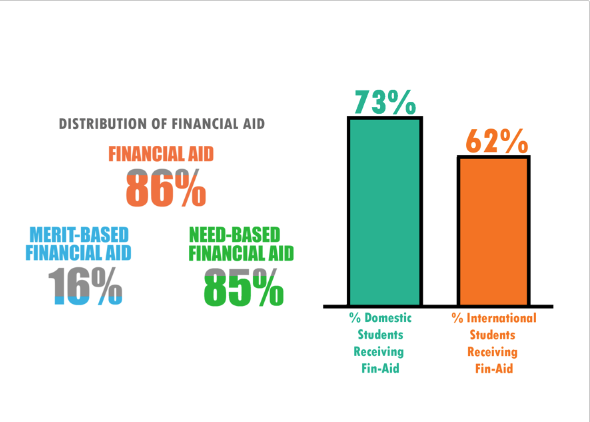Recently, the Board of Trustees made the decision to re-affirm the college’s need-blind policy for domestic students and meeting 100 percent of demonstrated need.
In an email to The S&B, Joseph Bagnoli, department head of admission and aid, vice president for enrollment and dean of admission and financial aid, said “It’s important to understand where the financial concerns of the Board originate. They are concerned that [the College’s] endowment spending is on an unsustainable trajectory over the long-term. [The College] receives far less in philanthropic gifts to replace endowment spending than our peers and [the College] has a far smaller share of students who pay the full comprehensive cost of attendance than those enrolled at our need-blind peer institutions.”
Bagnoli reported that 86 percent of students receive financial aid, including both merit and need-based aid. The average yearly need-based aid package for domestic students this academic year is $45,077.
According to Bagnoli, the proportion of students of low-income backgrounds is increasing, while the proportion of “students from families with a moderate amount of financial need” is decreasing. To accommodate those with extensive financial aid, the College has increasingly accepted students able to pay full tuition.
The recent announcement has garnered reactions from multiple students, who weighed in on the College’s supposed to commitment to providing significant aid.
“The reason I came to this school as opposed to peer institutions was because this school had a higher number of Pell Grant recipients and less of a New England wealth culture,” said Henry Brannan ’21.
However, he noted that the targeted groups of incoming students might be shifting in terms of their socioeconomic status.
“I have noticed that the College seems to be marketing itself to a more affluent demographic,” he said. “I understand that they have to pay the bills, but it comes at the cost of everyone else. If they’re admitting more affluent students, they’re just not admitting as many students from other income brackets.”
Bagnoli’s analysis of student wealth and financial aid seemed to confirm Brannan’s worries.
“Over time, as Grinnell and other colleges must fund increasing educational costs, there will be more pressure to enroll qualified students whose families can help pay for the education their institutions provide. By remaining committed to students with a high degree of financial need and by enrolling students with stronger academic credentials who have less financial need, there is less room in entering classes for those with moderate financial resources,” Bagnoli wrote.
Need-based financial aid takes on another layer when considering its relationship to international students. While community members have certain views about international students as being generally more affluent than domestic students, Nandita Banik ’20 expressed a more optimistic view of the perception of their wealth demographic.
“Grinnell College is one of the more generous colleges in terms of their financial aid package for international students and therefore, I would say there is a whole range of wealth demographics even within the international student community,” said Banik.
Bagnoli confirmed that international students are indeed able to receive financial aid, though the amount may not equal the percentage that domestic students receive. According to his reports, 62 percent of international students receive need-based financial aid, averaging about $38,487. A larger proportion of domestic students receive need-based aid, averaging at about $45,077.
The reasons for this need-aware policy are varied. A large implication of the policy is that the school is more able to guarantee that they will have enough resources to maintain a need-blind policy for domestic students. In fact, Bagnoli wrote that “need-blind admission for domestic students is part of Grinnell [College]’s identity and is highly valued by a variety of stakeholders,” which seems to imply that stakeholders are more concerned with the affordability of the school for domestic students than international students.
As the discussion of need and merit based financial aid continues, Brannan hopes that the College will remember its mission and commitment to students of varying identities and parts of the world.
“Given that there’s a strong case to be made that Grinnell, and other fancy liberal arts schools, really only exist, and were founded, to maintain intergenerational wealth and racialized, gendered and other unfair distributions of power, I think they probably owe it pretty strongly to the world to make up for that,” Brannan said.



































































